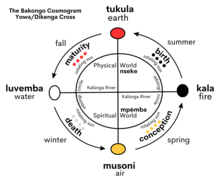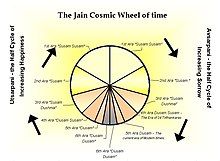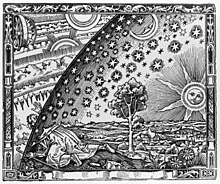Wheel of time
This articleneeds additional citations forverification.(January 2008) |
Thewheel of timeorwheel of history(also known asKalachakra) is a concept found in several religious traditions and philosophies, notably religions of Indian origin such asHinduism,Jainism,Sikhism,andBuddhism,which regard time ascyclicaland consisting of repeating ages. Many other cultures contain belief in a similar concept: notably, theQ'eropeople ofPeru,theHopipeople ofArizona,and theBakongo peopleofAngolaandDemocratic Republic of the Congo.
Ancient Africa[edit]

In traditionalBakongo religion,the four elements are incorporated into the Kongo cosmogram. This sacred wheel depicts the physical world (Nseke), the spiritual world of the ancestors (Mpémba), theKalûnga linethat runs between the two worlds, the sacred river (mbûngi) that began as a circular void and forms a circle around the two worlds, andthe path of the sun.Each element correlates to a period in the life cycle, which the Bakongo people also equate to the four cardinal directions and seasons. According to their cosmology, all living things go through this cycle.[1]
- Mbûngirepresentsaetherand is the void that exists before creation.
- Musoni time(South) representsairand is the period of conception that takes place during spring.
- Kala time(East) representfireand is the period of birth that takes place during summer.
- Tukula time(North) representsearthand is the period of maturity that takes place during fall.
- Luvemba time(West) representswaterand is the period of death that takes place during winter.
Ancient Rome[edit]
The philosopher and emperorMarcus Aureliussaw time as extending forwards to infinity and backwards to infinity, while admitting the possibility (without arguing the case) that "the administration of the universe is organized into a succession of finite periods".[2]: Book 5, Paragraph 13
Buddhism[edit]
TheWheel of Timeor Kalachakra is aTantricdeity that is associated withTibetan Tantric Buddhism,which encompasses all four main schools ofSakya,Nyingma,KagyuandGelug,and is especially important within the lesser-knownJonangtradition.
The Kalachakra tantra prophesies a world within which (religious) conflict is prevalent. A worldwide war will be waged which will see the expansion of the mystical Kingdom ofShambhalaled by a messianic king.
Hinduism[edit]
InHindu cosmology,kala(time) is eternal, repeating general events in four types of cycles. The smallest cycle is amaha-yuga(great age), containing fouryugas(dharmicages):Satya Yuga,Treta Yuga,Dvapara YugaandKali Yuga.Amanvantara(age ofManu) contains 71maha-yugas.Akalpa(day ofBrahma) contains 14manvantarasand 15sandhyas(connecting periods), which lasts for 1,000maha-yugasand is followed by apralaya(night of partial dissolution) of equal length, where a day and night make one full day. Amaha-kalpa(life of Brahma) lasts for 100 of Brahma's years of 12 months of 30 full days (100 360-day years) or 72,000,000maha-yugas,which is followed by amaha-pralaya(full dissolution) of equal length.[3]
Jainism[edit]

WithinJainism,time is thought to be a wheel that rotates for infinity without a beginning. This wheel of time holds twelve spokes that each symbolize a different phase in the universe's cosmological history. It is further divided into two equal halves having six eras in them. While in a downward motion, the wheel of time falls into what is known asAvasarpiṇīand when in an upward motion, enters a state calledUtsarpini.During both motions of the wheel, 24tirthankarascome forth to teach the three jewels or sacred Jain teachings of right faith, right knowledge, and right practice, then create a spiritual ford across the ocean ofrebirthfor humanity.[4][5]
Modern usage[edit]
Literature[edit]
In an interview included with theaudiobookeditions of his novels, authorRobert Jordanhas stated that his bestselling fantasy seriesThe Wheel of Timeborrows the titular concept from Hindu mythology.[6]
The first chapter of every book in the series begins with the lines:"The Wheel of Time turns, and ages come and pass, leaving memories that become legend. Legends fade to myth, and even myth is long forgotten when the Age that gave it birth comes again."[7]
Television[edit]
- Several episodes of the American TV seriesLostfeature a wheel that can be physically turned in order to manipulate space and time. In a series of episodes during the fifth season, the island on which the show takes place begins to skip violently back and forth through time after the wheel is pulled off its axis.
- The characterRust Cohlein the first season ofTrue Detectivemakes numerous references to his belief that events in time repeat, claiming that "Time is a flat circle".

See also[edit]
References[edit]
- ^Fu-Kiau, Kimbwandènde Kia Bunseki (2001).African cosmology of the Bântu-Kôngo: tying the spiritual knot: principles of life & living.Internet Archive. Brooklyn, N.Y.: Athelia Henrietta Press, Pub. in the name of Orunmila.ISBN978-1-890157-28-9.
- ^Aurelius, Marcus (2011).Meditations.Robin Hard. Oxford [England]: Oxford University Press.ISBN978-0-19-957320-2.OCLC757023454.
- ^Gupta, Dr. S. V. (2010). Hull, Robert;Osgood, Richard M. Jr.;Parisi, Jurgen; Warlimont, Hans (eds.).Units of Measurement: Past, Present and Future. International System of Units.Springer Series in Materials Science: 122.Springer.pp. 6–9 (1.2.4 Time Measurements).ISBN9783642007378.OCLC501804251.
- ^Bhattacharyya, Sibajiban (1970).Buddhist Philosophy From 350 to 600 A.D.Motilal Banarsidass.p. 3.ISBN9788120819689.OCLC91697.
- ^Dundas, Paul(2003).The Jains(2 ed.).Routledge.p. 20.ISBN9781134501656.OCLC71358145.
- ^"Robert Jordan chats about his 'Wheel of Time' series".CNN.Retrieved14 June2017.
- ^Jordan, Robert (1990).The Eye of the World.Orbit.ISBN978-0-356-50382-0.
- Sources
- Jordan, Robert (1990).The eye of the world.New York: T. Doherty Associates.ISBN0-312-85009-3.
